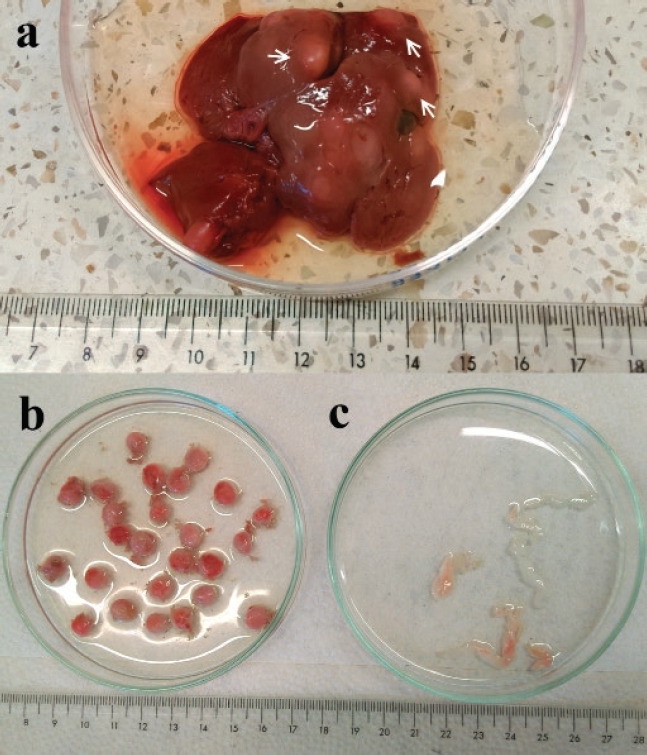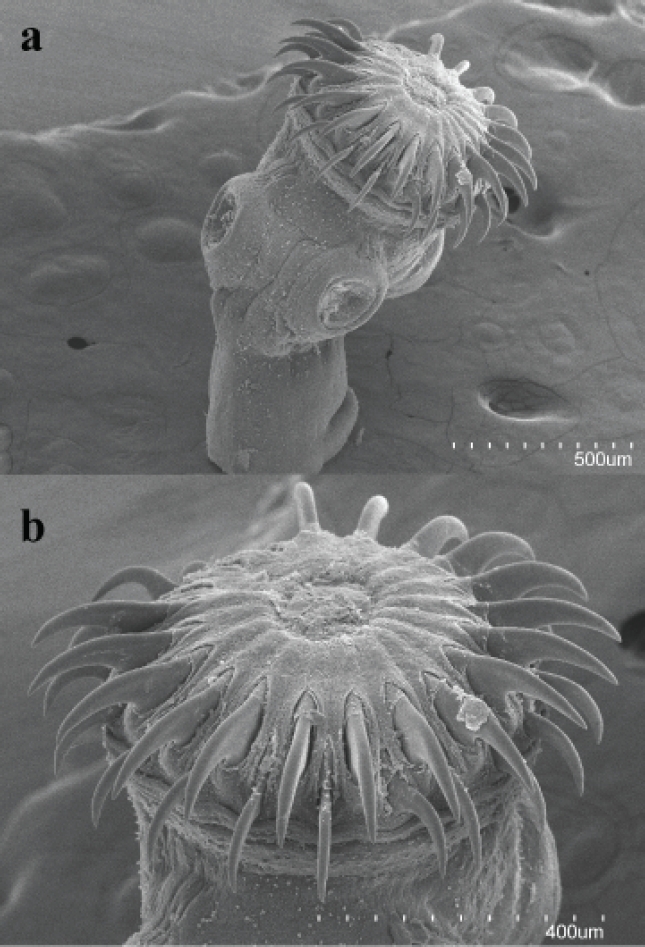Introduction
Adult cestodes of the genus Hydatigera Lamarck 1816 are intestinal parasites of felid or viverrid mammals and develop as larval stages or metacestodes in tissues and body cavities of their intermediate hosts (rodents; Lavikainen et al. 2016). The genus consists of four valid species: Hydatigera taeniaeformis (Batsch 1786), Hydatigera krepkogorski Schulz and Landa 1934, Hydatigera parva (Baer 1924), and Hydatigera kamiyaiLavikainen et al. 2016. Hydatigera taeniaeformis is the most common cestode parasitizing the small intestine of the domestic cat Felis catus and other wild felids (Jones and Pybus 2001). The life cycle of this cestode includes several rodent species as intermediate hosts, in which the strobilocercus usually develops in the liver. Although, H. taeniaeformis has a wide range of hosts, most studies have recorded it in domestic cats and synanthropic rodents, such as Mus musculus, Rattus rattus, and Rattus norvegicus (Lavikainen et al. 2016). A recent molecular study of specimens of H. taeniaeformis from Asia, Europe and Africa revealed the occurrence of cryptic species, resulting in the splitting of the species in three lineages: H. taeniaeformis sensu stricto, the recently discovered H. kamiyai and an undescribed species or an intraspecific variant, Hydatigera sp. (Lavikainen et al. 2016).
In México, there are records of H. taeniaeformis in domestic cats (Pacheco-Coronel 2010; Cantó et al. 2013) and synanthropic rodents (Caballero y Caballero 1939; Hierro-Huerta 1992; Pulido-Flores et al. 2005; Rodríguez-Vivas et al. 2011; Panti-May et al. 2015, 2017, 2018). However, there are few records of its occurrence in wild mammals. In the present work, we report for the first time the infection with H. taeniaeformis in the Yucatán squirrel Sciurus yucatanensis in the State of Yucatán, México.
On 1 May 2018, an adult male of S. yucatanensis was found run over by a car on the outskirts of Ebtún (20° 39’ 50.18’’ N, -88° 15’ 50.47’’ W), Valladolid, Yucatán. The specimen was collected for parasitological studies. At the laboratory, heart, lungs, gastrointestinal tract (from stomach to rectum), pancreas, liver and mesenteries, were dissected and examined for helminths using a stereoscope. We only found cysts containing larval stages of cestodes in the liver and mesenteries of the squirrel. Larval stages were studied with the aid of an optic microscope and a scanning electron microscopy (SEM). Drawings of rostellar hooks were made with the aid of micrographs taken with an optic microscope (Olympus IX81). For SEM micrographs, specimens were dehydrated using graded ethanol series and critical-point dried with carbon dioxide. Dry specimens were mounted on metal stubs, coated with a gold-palladium mixture and examined with a SEM (Hitachi SU1510). Total genomic DNA of one specimen of H. taeniaeformis was extracted using DNeasy Blood and Tissue Kit (QIAGEN, Hilden, Germany), following the manufacturer’s instructions. The D1-D3 region of the 28S rRNA gene was amplified using the polymerase chain reaction (PCR). The use of primers for PCR amplification, the thermo-cycling profile, and sequencing followed the protocols described by Hernández-Mena et al. (2017). The resulting sequences were assembled in Geneious Pro 4.8.4 (Biomatters Ltd.) to obtain a consensus sequence. The sequence was submitted to GenBank with the accession number MK514275. The host specimen was deposited in the Colección Mastozoológica (CM), Campus de Ciencias Biológicas y Agropecuarias, Universidad Autónoma de Yucatán (CM-1300), and helminth specimens fixed in ethanol were deposited in the Colección Nacional de Helmintos (CNHE), Instituto de Biología, Universidad Nacional Autónoma de México, México City (CNHE 10927).
Thirty cysts were collected, 29 in the liver and one in the mesenteries. Each cyst contained one larval stage, which measured from 5 to 130 mm (Figure 1a to c). The cestode specimens showed the diagnostic characteristics of the genus Hydatigera (i. e., large rostellar hooks and metacestodes as strobilocercus with prominent segmented strobilae; Lavikainen et al. 2016; Catalano et al. 2019). The general characteristics of all strobilocerci found, such as scolex with four suckers of 223 µm length by 120 µm wide; rostellum with double alternative crowns of 17 to 20 hooks each; longer hooks 368 to 409 µm in length and smaller hooks 224 to 246 µm in length (Figures 2, 3), were in accordance with descriptions of H. taeniaeformis given by Dobrovolny and Harbaugh (1934), Lavikainen et al. (2016), Panti-May et al. (2018). On the other hand, the newly generated sequence of the nuclear 28S rRNA gene was compared with other sequences available in GenBank through the BLASTn algorithm (https://blast.ncbi.nlm.nih.gov/Blast.cgi?PAGE_TYPE=BlastSearch), and allowed us to associate our sequence with H. taeniaeformis sensu stricto isolated from R. norvegicus (Genbank accession number: JN020350) and from R. rattus (JN020349) in India, with identity percentages of 100 % and 99.4 %, respectively.

Figure 1 Hydatigera taeniaeformis collected from the liver of Sciurus yucatanensis. a) H. taeniaeformis cysts (arrows) into the liver of S. yucatanensis. b) Hepatic cysts. c) Larval stages of H. taeniaeformis. Scale in centimeters.

Figure 3 Scanning electron micrographs of larvae of Hydatigera taeniaeformis. a) scolex, b) rostellum.
In México, larval stages of H. taeniaeformis have been found in the liver of several rodent species. It has been recorded from M. musculus in México City (García-Prieto et al. 2012) and Yucatán (Rodríguez-Vivas et al. 2011; Panti-May et al. 2015, 2017, 2018), R. rattus in Hidalgo (Pulido-Flores et al. 2005) and Yucatán (Rodríguez-Vivas et al. 2011; Panti-May et al. 2015, 2017, 2018), and R. norvegicus in México City (Caballero y Caballero 1939) and Michoacán (Hierro-Huerta 1992). In wild rodents, records have been made from Sigmodon hispidus in Nuevo León (Gutiérrez-González 1980) and Sigmodon toltecus in Yucatán (Panti-May et al. 2018). Adult worms of H. taeniaeformis have been collected from the intestines of feral and domestic cats in México City (Pacheco-Coronel 2010) and Queretaro (Cantó et al. 2013), respectively.
In this study we report for the first time the natural infection of a squirrel with H. taeniaeformis in México. In the Americas, there are few reports on the infection of H. taeniaeformis in squirrels. In the United States, the red squirrel Sciurus niger rufiventer (Dobrovolny and Harbaugh 1934; Rausch and Tiner 1948) and the gray squirrel Sciurus carolinensis carolinensis (Harkema 1936; Parker and Holliman 1971) were found naturally infected, and recently in Brazil, the Ingram’s squirrel Guerlinguetus ingrami, was reported harboring strobilocercus larvae of this cestode (Mello et al. 2018).
Previous studies in Yucatán have reported that H. taeniaeformis is a common parasite of synanthropic rodents (M. musculus and R. rattus) in urban and rural localities (Rodríguez-Vivas et al. 2011; Panti-May et al. 2015, 2017, 2018). The prevalence and intensity of infection in these rodents varies from 1.4 % to 28.8 % and from one to four cysts, respectively. Although there are no records in domestic and feral cats, the presence of metacestodes in synanthropic rodents suggests that cats harbor the adult stages and release cestode eggs in the external environment. The examined squirrel was found close to Ebtún village which could indicate that the source of the infection may be a domestic or feral cat instead of a wild felid. Previous studies have also reported H. taeniaeformis-infected squirrels in sites close to human settlements such as forest, farm houses, or cities (Dobrovolny and Harbaugh 1934; Harkema 1936; Mello et al. 2018). Sciurus yucatanensis is an arboreal species but it can spend time on the ground, which may favor the ingestion of infective eggs in the external environment.
The present work represents the first record of a cestode parasitizing a squirrel species in México. Previous to our report, only 10 nematode taxa had been recorded from Cynomys ludovicianus, C. mexicanus, Sciurus aureogaster, S. deppei, and Otospermophilus variegatus, namely Spirura infundibuliformis McLeod 1933, Subulura sp., Oxyuridae gen. sp., Sciurodendrium bravohollisae Falcón-Ordaz and Lamothe-Argumedo 2006, Syphatineria sp., Trichuris sp., Boehmiella wilsoni Lucker 1943, Citellina abdita (Caballero y Caballero 1937), Trichuris citelli Chandler 1945, and Rauschtineria sp. (García-Prieto et al. 2012; Martínez-Salazar et al. 2016). This study increases to 11 the total number of helminth species known from squirrels in México.











 nueva página del texto (beta)
nueva página del texto (beta)



